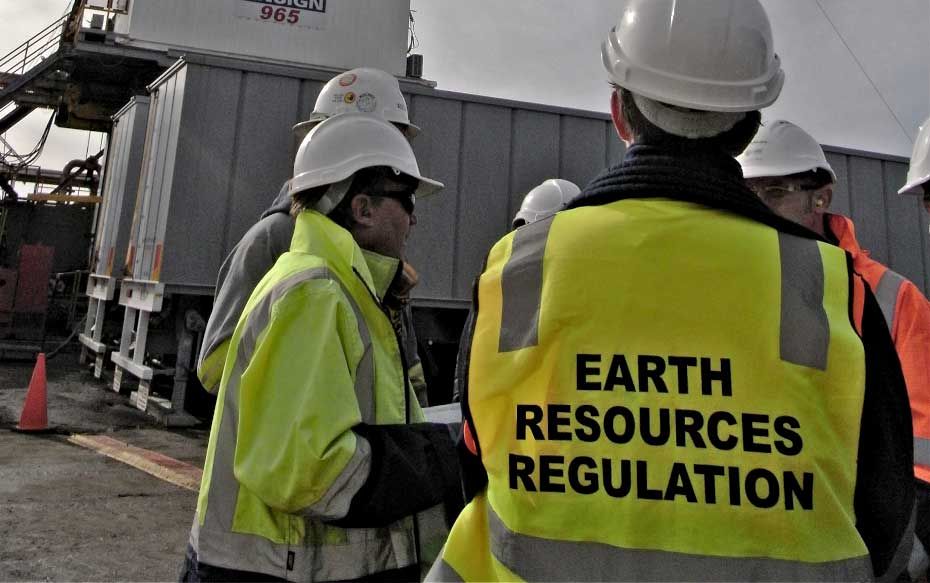Compliance and enforcement

We regulate nearly 1,600 sites including almost 900 quarries; over 300 mine and prospecting licences; and over 50 petroleum licences.
We monitor and enforce compliance with the state’s mineral and energy resources legislation at these sites through a range of activities including:
- providing educational material including guidelines and codes of practice
- monitoring practices and processes through ad hoc and targeted inspections
- following up on complaints
- attendance at community reference group meetings
- enforcement actions designed to compel compliance, including issuing directions and improvement notices, issuing infringement notices, and recommending matters for prosecution.
Interim Compliance Strategy 2021–2022
The Earth Resources Regulator’s Interim Compliance Strategy outlines the way that we undertake compliance activities, the way we prioritise our work using a risk based approach, and our use of a graded compliance strategy, spanning from education to enforcement and prosecution, where the outcome is appropriate to the level of risk posed.
The Earth Resources Regulator will maintain a priority focus on preventing and responding to the key risks posed by minerals, extractives and petroleum sites to protect public safety, land, infrastructure and the environment, including (but not limited to):
- Fire – coal mines, plant and equipment fires
- Stability – mines and quarries batters, integrity of tailings storge facilities and land erosion
- Rehabilitation – progressive and final rehabilitation of mines, quarries, petroleum and exploration sites
- Community impacts – including dust, noise, vibrations and public safety of sites
- Authorisations and access – including Native Title, land access and necessary authorisations
The Earth Resources Regulator will undertake compliance activities including targeted inspections and audits focusing on addressing these key risks.
In February 2021, the Earth Resources Regulator commenced an in-depth review of our compliance model. This review will consider all aspects of our compliance activities across the state.
By publishing the Interim Compliance Strategy, the Earth Resources Regulator aims to assure the community and other key stakeholders that compliance activities will continue in a consistent manner, underpinned by a shared understanding of objectives, regulatory approach and goals, while the review is completed. A new compliance strategy will be developed on conclusion of the review, to reflect its findings and recommendations.
The Interim Compliance Strategy can be accessed via the below link:
- Earth Resources Regulation Compliance Strategy 2021-2022 (PDF - 423.3 KB)
- Earth Resources Regulation Compliance Strategy 2021-2022 (WORD - 741.5 KB)
Industry sector focus
For each industry sector, we will focus on:
- coal: fire, dust, batter stability, rehabilitation
- gold and other metals - dust, stability, rehabilitation, water
- rock (hard and soft rock): blasting, dust, stability, extraction without permission
- sand/clay quarries: dust, water quality, stability of tailings storage, rehabilitation, batter stability, water removal
- gypsum: vegetation, rehabilitation
- minerals sands: dust, water, rehabilitation
- petroleum: well integrity.
Working with other regulators
We have agreements in place with other government agencies to:
- assist decision-making
- help the industry sectors get a better understanding of their obligations
- and ensure that our decisions are transparent and consistent.
What an operator must do to comply
After an approval has been granted, an operator must keep us up-to-date with information on its activities. This includes:
- completing reports on time
- contacting us if issues arise or if guidance is needed
- managing risks
- paying attention to conditions.
We conduct inspections to make sure that operators are meeting the conditions on their approvals.
How we support compliance
We will conduct proactive activities to encourage compliance including industry seminars and forums; guidance materials; and community engagement activities.
We also publish case studies and materials on ‘how it should be done’ to assist compliance.
Enforcement
We use a range of methods to address non-compliance, from requiring the remedy of identified risks or breaches, through to financial penalties and prosecutions.
We will take enforcement action proportionate to the seriousness of the non-compliance.
Enforceable undertakings
An enforceable undertaking may be considered by the Minister if there are reasonable grounds to believe an authority holder has contravened or is likely to contravene the Act or regulations and in certain other circumstances.
Current enforceable undertakings are on our enforceable undertakings page.
Page last updated: 17 Nov 2023